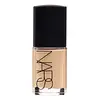What's inside
What's inside
 Key Ingredients
Key Ingredients

 Benefits
Benefits

 Concerns
Concerns

 Ingredients Side-by-side
Ingredients Side-by-side

Water
Skin ConditioningDimethicone
EmollientHomosalate
Skin ConditioningPropanediol
SolventEthylhexyl Salicylate
UV AbsorberAlcohol Denat.
AntimicrobialOctocrylene
UV AbsorberNiacinamide
SmoothingVinyl Dimethicone/Methicone Silsesquioxane Crosspolymer
Synthetic Fluorphlogopite
PEG-30 Dipolyhydroxystearate
EmulsifyingTocopherol
AntioxidantCaffeine
Skin ConditioningDisteardimonium Hectorite
StabilisingPolyglyceryl-4 Diisostearate/Polyhydroxystearate/Sebacate
EmulsifyingMagnesium Sulfate
Phenoxyethanol
PreservativeDisodium Stearoyl Glutamate
CleansingScutellaria Baicalensis Root Extract
AstringentAluminum Hydroxide
EmollientParfum
MaskingLimonene
PerfumingBenzyl Salicylate
PerfumingCitral
PerfumingTitanium Dioxide
Cosmetic ColorantCI 77491
Cosmetic ColorantCI 77492
Cosmetic ColorantCI 77499
Cosmetic ColorantWater, Dimethicone, Homosalate, Propanediol, Ethylhexyl Salicylate, Alcohol Denat., Octocrylene, Niacinamide, Vinyl Dimethicone/Methicone Silsesquioxane Crosspolymer, Synthetic Fluorphlogopite, PEG-30 Dipolyhydroxystearate, Tocopherol, Caffeine, Disteardimonium Hectorite, Polyglyceryl-4 Diisostearate/Polyhydroxystearate/Sebacate, Magnesium Sulfate, Phenoxyethanol, Disodium Stearoyl Glutamate, Scutellaria Baicalensis Root Extract, Aluminum Hydroxide, Parfum, Limonene, Benzyl Salicylate, Citral, Titanium Dioxide, CI 77491, CI 77492, CI 77499
Water
Skin ConditioningDimethicone
EmollientTriethylhexanoin
MaskingButylene Glycol
HumectantGlycerin
HumectantIsostearic Acid
CleansingPolymethylsilsesquioxane
PEG-10 Dimethicone
Skin ConditioningDisteardimonium Hectorite
StabilisingDimethicone/Vinyl Dimethicone Crosspolymer
Skin ConditioningBis-Butyldimethicone Polyglyceryl-3
CleansingSodium Glutamate
MaskingSorbitan Sesquiisostearate
EmulsifyingPaeonia Albiflora Root Extract
Skin ConditioningCurcuma Longa Root Extract
MaskingPolysilicone-2
Aluminum Hydroxide
EmollientTocopherol
Antioxidant1-Methylhydantoin-2-Imide
Skin ConditioningAscorbyl Glucoside
AntioxidantGlucosyl Hesperidin
HumectantPhenoxyethanol
PreservativeSodium Dehydroacetate
PreservativeBenzoic Acid
MaskingIron Oxides
CI 77891
Cosmetic ColorantWater, Dimethicone, Triethylhexanoin, Butylene Glycol, Glycerin, Isostearic Acid, Polymethylsilsesquioxane, PEG-10 Dimethicone, Disteardimonium Hectorite, Dimethicone/Vinyl Dimethicone Crosspolymer, Bis-Butyldimethicone Polyglyceryl-3, Sodium Glutamate, Sorbitan Sesquiisostearate, Paeonia Albiflora Root Extract, Curcuma Longa Root Extract, Polysilicone-2, Aluminum Hydroxide, Tocopherol, 1-Methylhydantoin-2-Imide, Ascorbyl Glucoside, Glucosyl Hesperidin, Phenoxyethanol, Sodium Dehydroacetate, Benzoic Acid, Iron Oxides, CI 77891
 Reviews
Reviews

Ingredients Explained
These ingredients are found in both products.
Ingredients higher up in an ingredient list are typically present in a larger amount.
Aluminum Hydroxide is a form of aluminum. It can be naturally found in nature as the mineral gibbsite. In cosmetics, Aluminum Hydroxide is used as a colorant, pH adjuster, and absorbent.
As a colorant, Aluminum Hydroxide may add opacity, or reduce the transparency. Aluminum hydroxide is contains both basic and acidic properties.
According to manufacturers, this ingredient is an emollient and humectant. This means it helps hydrate the skin.
In medicine, this ingredient is used to help relieve heartburn and help heal ulcers.
There is currently no credible scientific evidence linking aluminum hydroxide in cosmetics to increased cancer risk.
Major health organizations allow the use of aluminum hydroxide in personal care products and have not flagged it as a carcinogenic risk at typical usage levels.
Learn more about Aluminum HydroxideDimethicone is a type of synthetic silicone created from natural materials such as quartz.
What it does:
Dimethicone comes in different viscosities:
Depending on the viscosity, dimethicone has different properties.
Ingredients lists don't always show which type is used, so we recommend reaching out to the brand if you have questions about the viscosity.
This ingredient is unlikely to cause irritation because it does not get absorbed into skin. However, people with silicone allergies should be careful about using this ingredient.
Note: Dimethicone may contribute to pilling. This is because it is not oil or water soluble, so pilling may occur when layered with products. When mixed with heavy oils in a formula, the outcome is also quite greasy.
Learn more about DimethiconeDisteardimonium Hectorite comes from the clay mineral named hectorite. It is used to add thickness to a product.
It can also help stabilize a product by helping to disperse other ingredients.
Hectorite is a rare, white clay mineral.
Learn more about Disteardimonium HectoritePhenoxyethanol is a preservative that has germicide, antimicrobial, and aromatic properties. Studies show that phenoxyethanol can prevent microbial growth. By itself, it has a scent that is similar to that of a rose.
It's often used in formulations along with Caprylyl Glycol to preserve the shelf life of products.
Tocopherol (also known as Vitamin E) is a common antioxidant used to help protect the skin from free-radicals and strengthen the skin barrier. It's also fat soluble - this means our skin is great at absorbing it.
Vitamin E also helps keep your natural skin lipids healthy. Your lipid skin barrier naturally consists of lipids, ceramides, and fatty acids. Vitamin E offers extra protection for your skin’s lipid barrier, keeping your skin healthy and nourished.
Another benefit is a bit of UV protection. Vitamin E helps reduce the damage caused by UVB rays. (It should not replace your sunscreen). Combining it with Vitamin C can decrease sunburned cells and hyperpigmentation after UV exposure.
You might have noticed Vitamin E + C often paired together. This is because it is great at stabilizing Vitamin C. Using the two together helps increase the effectiveness of both ingredients.
There are often claims that Vitamin E can reduce/prevent scarring, but these claims haven't been confirmed by scientific research.
Learn more about TocopherolWater. It's the most common cosmetic ingredient of all. You'll usually see it at the top of ingredient lists, meaning that it makes up the largest part of the product.
So why is it so popular? Water most often acts as a solvent - this means that it helps dissolve other ingredients into the formulation.
You'll also recognize water as that liquid we all need to stay alive. If you see this, drink a glass of water. Stay hydrated!
Learn more about Water